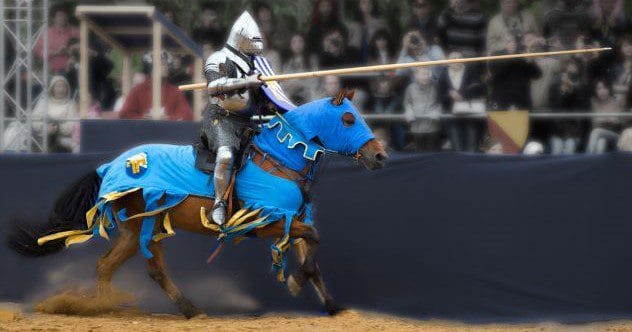History might make it seem like they preferred conflict, but medieval and Renaissance European monarchs actually invested considerable time and money in securing peace—or at least appearing to do so. The two-week-long festival of the “Field of the Cloth of Gold” in 1520 is a prime example.
This event brought together long-time foes England and France for a fortnight of friendly tournaments and feasts, with the aim of solidifying their newfound friendship. However, both kings are believed to have had ulterior motives, turning it into one of history’s most extravagant diplomatic displays. Here are ten fascinating facts about the meeting between Kings Francis I and Henry VIII, which evolved into one of the most celebrated festivals ever.
10 It Was Really about Young Kings’ Egos
It might not be surprising that the two kings, who seemed to think they could party their way to peace, were both under 30. Francis I of France was 25 during the Field of the Cloth of Gold, while Henry VIII of England was 28. However, the meeting was actually a requirement of the Treaty of London, a peace treaty agreed upon by the major European powers at the time.
Officially, the meeting was intended to strengthen the young monarchs’ friendship and celebrate the end of almost two centuries of war between their countries. Yet, while peaceful, it did little to stop the two young kings from trying to outdo each other.
Each wanted to make a grand statement for the history books about their self-perception and their country’s image, leading to over-the-top displays of wealth, power, and refinement. Their competitive efforts resulted in an extravaganza unlike any seen before.[1]
9 Thousands of People Attended
There isn’t actually a place called the “Field of the Cloth of Gold.” The event was held in the Pale of Calais, a valley between Guînes and Ardres in what is now northern France but was then under English rule. So, how did the meeting get its name? To flaunt their power and wealth, each king brought about 6,000 people.
Such large groups needed lodging, so tents and pavilions were set up. Many were made from luxurious fabrics like gold cloth. The event gets its name from this opulent accommodation. Moreover, since many guests were nobles, their clothes were also incredibly luxurious. Some of Henry VIII’s party wore gold coats, which were initially mistaken for armor, causing brief alarm among the French.[2]
8 The Kings Led Teams in Arms Contests
Part of achieving peace during the Renaissance involved demonstrating readiness for war. This was done through military competitions and tournaments, which were central to the Field of the Cloth of Gold. Up to 300 men from each side, including both kings, competed over two weeks in jousting, team battles on horseback (“tourneys”), and foot combat separated by a barrier.
Henry and Francis were both praised for their jousting, though they competed against volunteers rather than each other to avoid disputes. However, bad weather led to the cancellation of several contests, so Henry, Francis, and their men looked for less weather-dependent entertainment, leading to their only physical encounter during the event.[3]
7 The Kings Wrestled Each Other
Despite often appearing portly in portraits, Henry VIII was reportedly a skilled athlete in his younger days, which mostly meant being good at archery and jousting. He also had a passion for wrestling, shared by Francis. In fact, for Francis, wrestling was not just a passion but part of his identity. Besides being King of France, he was the Duke of Brittany, a region famous for its wrestlers.
When outdoor activities were canceled at the Field of the Cloth of Gold, the French began challenging the English to wrestling matches, which became so popular that even priests participated. Eventually, an enthusiastic Henry grabbed Francis by the collar and challenged him to a match. However, Henry was no match for Francis, whose signature move was the “tour de Bretayne.” English historians were hesitant to record Henry’s defeat. Still, he regained some dignity by outperforming Francis with his longbow.[4]
6 Henry VIII Had a “Portable Palace” with a Wine Fountain
Attendees at the Field of the Cloth of Gold hadn’t heard of “glamping,” but they certainly knew how to do it in style. The soldiers’ luxurious pavilions paled in comparison to Henry’s accommodation: a huge portable palace for banquets and parties. It covered about 328 square feet (30.5 square meters) and was almost 40 feet tall (12.2 meters), with four blocks of rooms around a central courtyard.
Designed to resemble London’s Hampton Court Palace, it was mainly made of timber covered in canvas that looked like stone. Its stained-glass windows led the French to call it the Crystal Palace. To further impress, Henry installed an endless wine fountain where guests could freely drink.[5]
5 Feasts Included up to 50 Dishes, and Even the Sculptures Were Edible
While Henry had his portable palace, the French camp’s centerpiece was a stunning 120-foot (36.6-meter) tall gold tent. However, it was quickly taken down due to bad weather and never hosted any feasts. This did not deter anyone. The 12,000 attendees consumed 29,000 fish, 98,000 eggs, over 6,000 birds, 2,200 sheep, and 216,000 gallons of wine.
Amazingly there were no accidents at the archery range! Most supplies came from nearby merchants, though the English camp shipped herds of deer and sheep. At the three main feasts attended by the kings, around fifty dishes were offered, showcasing the finest French and English food of the day. Swans, peacocks, venison, and even dolphin were served. For dessert, tables were decorated with edible sculptures made from marzipan and sugar, depicting biblical scenes.[6]
4 Both Kings Tried to Become Prisoners
Besides material goods and sporting talent, the kings fiercely competed in gestures of friendship at the Field of the Cloth of Gold. Strangely, each king tried to show how submissive they were to the other. Francis went first. Early on June 17, he rode to Henry’s castle in Guînes. Uninvited, he demanded entry and was admitted to Henry’s bedchamber, surprising the latter.
Francis declared himself Henry’s prisoner, showing he trusted Henry enough not to harm him despite giving him the opportunity to do so. He then helped Henry dress. Although the stunt showed trust, it wasn’t the “bromance” it seemed. It subtly asserted Francis’s right to invade the other king’s privacy. Henry reciprocated with his own surprise visit two days later.[7]
3 It Ended with a Giant Fiery Dragon Display
On June 23, Cardinal Wolsey held a mass in a temporary chapel, reportedly as splendid as Henry’s “portable palace,” adorned with tapestries, silver, and a bejeweled crucifix. Two organs played music, and one historian described Wolsey’s ceremony as having “as much pomp as if he had been pope.”
However, everyone noticed a huge, fire-breathing dragon darting across the sky, frightening many. It was a kite, possibly pulled by a wire, with impressive pyrotechnics. Reports are ambiguous about whether it was meant to be a dragon—a nod to Henry’s Welsh ancestors—or Francis’s symbol, a salamander, or a combination of both.[8]
2 The “Universal Peace” It Aimed for Did Not Last
Cardinal Wolsey aimed for more than just a display of kings or a friendship when he organized the Field of the Cloth of Gold. He sought to secure universal peace among Christian Europe’s major powers to unite against the growing Ottoman Empire. Today, it’s clear that nearly every attempt at “universal peace” has failed, and Wolsey’s was no exception, though it seemed successful at the end.
The most significant diplomatic incident was Henry’s arrival with a shaved beard, as they had agreed not to shave so they could compare them. Henry was excused by claiming his wife preferred him without it.
However, just two weeks later, Henry met with Holy Roman Emperor Charles V, who was distrusted by the French for wanting Milan back from them. They agreed not to ally with France for at least two years. Francis and Charles went to war in 1521, and Henry sided with the Empire.[9]
1 It Happened Again in 1532, But Was Much Smaller
Despite Henry helping Charles V against France, he and Francis tried to reconcile in Calais and Boulogne in October 1532. This time, there were no grand goals or pop-up palaces, and Henry brought only 2,000 courtiers and servants, including Anne Boleyn, recently titled the Marquis of Pembroke. She was the reason for the visit.
Henry wanted to marry Anne but needed a divorce. This was typically unacceptable to the Pope, as Henry was still Catholic. However, Francis was negotiating with the Pope about a marriage for one of his sons. If Henry could befriend Francis, the French king might help secure the Pope’s permission for a divorce, or at least public tolerance of his marriage to Anne.
Though they exchanged expensive gifts and played host, they failed to build a lasting friendship. Henry tried to invade France again in 1544.[10]
The Field of the Cloth of Gold remains a fascinating example of Renaissance diplomacy and royal extravagance. While it failed to secure lasting peace, it left behind a legacy of opulent displays and intriguing historical anecdotes.
Explore more historical events and leave your comment below!










